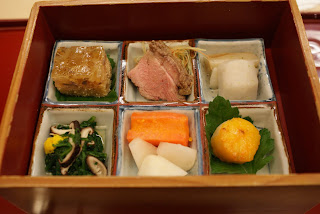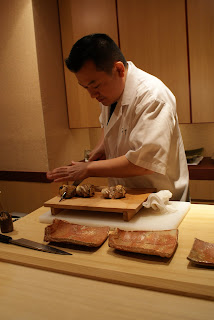The open kitchens in American fine dining are a relatively new concept. In order to increase the entertainment of its guests, restauranteurs began designing spaces that expose the action in the kitchen. This has been a long tradition in Japanese restaurants. We are all familiar with the sushi bar, but the Japanese ryotei seats guests at the counter of kaiseki tradition. On my most recent trip to Japan, I had three memorable meals at the counter, where the intimate interaction with the technique driven chefs exposes another layer of their skills.
Yoshihiro Murata received international recognition with his beautiful book, Kaiseki, the exquisite cuisine of Kyoto's Kikunoi restaurant. I always visit Kikunoi when I am in Japan. The service and style of the cuisine are very special. A kaiseki meal often begins with a course known as hassun (八寸), which is a presentation of many appetizers in a seasonal theme. The end of September hassun is presented in a cricket cage, with a sprig of hagi, Japanese bush clover. The cricket cage symbolizes the passing of summer's chirping insects. Removing the cage reveals the fall delicacies of barracuda sushi, ginko nuts, eel roe in mousse, grilled chestnuts, and other hors d'oeuvres, presented on a leaf of kuzu (arrowroot).
 The kaiseki meal follows a certain progression, with appetizers followed by a clear soup, then sashimi, grilled foods, steamed foods, and so on. The beautiful lacquerware and seasonal motifs on the plateware are all a part of the experience. About half way through the meal, the chef uses a dish made by one of the greatest masters of twentieth century ceramics, Kitaoji Rosanjin. The dish imitates a painters palette, and facilitates six individual variations of texture and flavor. Here, the selections include (clockwise from top left) a terrine of mushrooms and ayu roe, duck breast with negi, braised satoimo (taro root), glazed scallop on a leaf of shungiku, asian pear and salmon stuffed with egg yolk, and a salad of shiitake and marinated shungiku (edible chrysanthemum).
The kaiseki meal follows a certain progression, with appetizers followed by a clear soup, then sashimi, grilled foods, steamed foods, and so on. The beautiful lacquerware and seasonal motifs on the plateware are all a part of the experience. About half way through the meal, the chef uses a dish made by one of the greatest masters of twentieth century ceramics, Kitaoji Rosanjin. The dish imitates a painters palette, and facilitates six individual variations of texture and flavor. Here, the selections include (clockwise from top left) a terrine of mushrooms and ayu roe, duck breast with negi, braised satoimo (taro root), glazed scallop on a leaf of shungiku, asian pear and salmon stuffed with egg yolk, and a salad of shiitake and marinated shungiku (edible chrysanthemum).

This is the season for
hamo, a seawater eel from Osaka Bay and the Inland Sea. It is larger and leaner than the freshwater eel unagi, but it is more seasonally celebrated. The many small bones are impossible to remove, so they are cut into tiny, edible pieces by a heavy knife known as
hamokiri bocho. The sous-chef, Maruyama-san, told me his hamokiri cost about 400 dollars. He uses the
hamo no honekiri technique to make the proscribed twenty cuts per inch (
issun ni nijyuyon hocho).

A proper Japanese meal consists of
shokuji (食事), serving rice, pickles and miso soup, which come at the end of the meal. Maruyama-san presents the rice course in an
okama, an old fashioned earthenware pot that fits into a charcoal stove. Of course, a kaiseki restaurant will enhance these simple dishes with their own style. On this occasion, the rice has been garnished with
uni and
nori, and the white miso soup is pureed with
yurine (lily bulbs).

The next meal would be my first time dining at Hisao Nakahigashi's famous restaurant,
Sojiki Nakahigashi. It is a very small restaurant, and the seats are often booked several months in advance. Although the Michelin Guide only rates the restaurant with one star, it is one of the hardest reservations to get in Kyoto. The clever name of his restaurant is an indication of the chef's
tsumigusa (foraged, or freshly picked) cuisine. The word
sojiki is a creation of the chef, but it suggests "eating leaves or grass." There is a more subtle suggestion that it is an apothecary cuisine, of sorts, and it was this inclusion of wild and bitter flavors that I found fascinating.
The chef presents his
hassun course on a leaf of
satoimo, and garnished with a shaft of
susuki, one of the seven flowers of autumn. In the glass dish is a wonderful salad of figs and white miso, a variety of nuts include chestnuts, a ginko nut stuffed with egg yolk, and broiled mackerel stuffed with walnut (amazing). There were also some
tsukudani-style
dojo, a small eel-like freshwater fish often caught in the rice paddies!

The chef's dishes are often composed of contrasting textures and sensations. He always offers seasonal variations of his
koi zukuri, carp sashimi served with a salad of dozen vegetables and herbs, toasted
sansho peppercorns, the famous
natto made at the nearby temple of Daitoku-Ji, and a sherbet made of daikon! Alternating bites of the fish and veggies, dipped in the spicy sansho, the salty natto and the cool, refreshing sherbet stimulates all the senses, the tingling sensation of sansho gradually dissipating into the cleansing sherbet. It could be regarded as Nakahigashi's
gargouillou!

The chef preparing a wonderful broth to serve with his rich line-caught
hamo and ginger jelly, green beans, tomato and yuzu. The balance was perfection, acidic yuzu complemented by the rich and smoky eel with tomato, the brightness of ginger, and the slight bitterness of the yuzu peel. Over the chef's shoulder, a shaft of rice is tied to a paper-folded lightning bolt, a
shinto symbol of respect for nature. You can also see his charcoal stove behind him with the
okama inserts.

This is me enjoying a refreshing, crunchy salad of green beans, thinly sliced
myoga, spaghetti squash, and purple chrysanthemum, with a dressing of sesame and white miso. This fresh and light course with its firm textures was a nice little intermezzo.

Another small course in the meal demonstrates several levels of the chef's genius. He does an exciting job of pairing his courses with a complimentary sauce, or in this case, a beverage. Fresh kyoho grape juice is served alongside a small salad of poached and peeled plum tomato, a salty and bitter pesto made of
ayu (a small, sweet-fleshed entrails, a dab of hot mustard, and a slice of pepper served with its blossom. The dish was a marvelous combination of flavors, and I noticed that the glass was cut from the base of a European wine glass, an incredibly subtle and clever connection to the grape juice. The chef often uses several parts of the same plant in his dishes. In this case, using the pepper and its blossom. In another course with sweet potatoes, he also braised the leaves of the plant.

After the
shokuji, which the chef serves unadorned (just plain white rice), the chef scrapes the sides of his
okama for a special treat. The rice crust that has caramelized to the bottom of the pot is called
okoge, a crunchy snack that is fun and tasty with the toasted green tea served after the meal. This reminded me of my days in Switerland serving fromage fondue in earthenware pots. When you reached the bottom, the cheese had caramelized into a layer that you peeled off and pop in your mouth. They called it
la religieuse.

The meal at
Sojiki Nagakigashi is always concluded in the same way, cold coffee, burnt sugarcane candies and a rare, unsalted cheese from Shiga Prefecture. It is such a little known product that many of my Japanese friends had never heard of it. This was really an inspiring meal for me, reflecting a style of cooking from a mostly bygone era.

Once I returned to Tokyo, I had my first three star dining experience. Chef and owner Toru Okuda of
Koju has received a lot of accolades for his small Ginza restaurant. As would be expected from a three star restaurant, the service was great and the glassware and plateware were beautiful, but his style was unique and very classy. The plates were mostly rough and unglazed ceramics, and the glassware was sleek and modern. It made for a nice contrast. The first course was grilled abalone, sliced and served with lime and salt. This is one of the chef's departures from traditional Japanese seasoning of wasabi and soy sauce. Very minimal to let the natural flavors shine.

In the sashimi course, the chef invites the diner to evaluate the flavor of lime and salt against wasabi and soy. Two pieces of each cut are offered for comparison. There were four types of sashimi. Two cuts of tuna, the
chutoro from the highly prized middle section of the belly, and
akami, the familiar deep red loin section, squid (which is always one of my favorite sashimi items in Japan, but something we rarely see in America), and
madai, a sea bream which the Japanese regard as the king of fish, served here with the skin. I found that the tuna was best with wasabi, while the other two were best with lime and salt.

Here, chef Okuda slices barracuda rolled with
matsutake and grilled. You can see that there is no bar or counter between the diner and the chef's work table. It was as if he were on the other side of the dinner table, a very open design which requires impeccable cleanliness and technical finesse at all times, a lot of fun to watch.

This is the
yakimono, or grilled course, decorated with autumn leaves of maple and magnolia. The rolled barracuda, unagi served both
shirayaki (unseasoned) and
kabayaki (glazed with sauce), accompanied by ginko nuts and
tatami iwashi, a toasted cracker made of tiny sardines, dried and pressed into thin sheets. Beautiful and tasty! This was one of the few glazed plates used in the meal, with the shine and color imitating the autumn leaves garnishing it.

Japanese kaiseki always gives a very strong impression of time and a connection with nature that I adore. As is always the case with something so seemingly simple, it requires an enormous amount of work to make something so minimal into something so rewarding.
The kaiseki meal follows a certain progression, with appetizers followed by a clear soup, then sashimi, grilled foods, steamed foods, and so on. The beautiful lacquerware and seasonal motifs on the plateware are all a part of the experience. About half way through the meal, the chef uses a dish made by one of the greatest masters of twentieth century ceramics, Kitaoji Rosanjin. The dish imitates a painters palette, and facilitates six individual variations of texture and flavor. Here, the selections include (clockwise from top left) a terrine of mushrooms and ayu roe, duck breast with negi, braised satoimo (taro root), glazed scallop on a leaf of shungiku, asian pear and salmon stuffed with egg yolk, and a salad of shiitake and marinated shungiku (edible chrysanthemum).
 The meal at Sojiki Nagakigashi is always concluded in the same way, cold coffee, burnt sugarcane candies and a rare, unsalted cheese from Shiga Prefecture. It is such a little known product that many of my Japanese friends had never heard of it. This was really an inspiring meal for me, reflecting a style of cooking from a mostly bygone era.
The meal at Sojiki Nagakigashi is always concluded in the same way, cold coffee, burnt sugarcane candies and a rare, unsalted cheese from Shiga Prefecture. It is such a little known product that many of my Japanese friends had never heard of it. This was really an inspiring meal for me, reflecting a style of cooking from a mostly bygone era. 